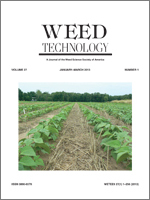Weeds are the main constraint in the adoption of zero-till, dry-seeded rice systems because weeds and rice emerge simultaneously in these systems, and there is no standing water at crop establishment to suppress weeds. A study was conducted during the wet season of 2011 and the dry season of 2012 at the International Rice Research Institute to evaluate the performance of different herbicides in mechanized-sown, zero-till dry-seeded rice. Among the treatments evaluated, oxadiazon followed by penoxsulam cyhalofop followed by one hand-weeding at 42 d after sowing, provided 23 to 35% higher yield than the nontreated control. The yields in the oxadiazon-treated plots were similar to those in the weed-free plots. Some weed species, including eclipta and doveweed, were not controlled by the evaluated herbicides. Therefore, there is a need to evaluate additional herbicides and to integrate them with cultural weed management strategies to manage such problematic weeds.
Nomenclature: Cyhalofop; oxadiazon; penoxsulam; doveweed; Murdannia nudiflora (L.) Brenan MUDNU; eclipta; Eclipta prostrata (L.) L. ECLAL; rice; Oryza sativa L. ORYSA
Las malezas son la principal limitante para la adopción de la labranza cero en sistemas de arroz sembrado en secano porque en estos sistemas las malezas y el arroz emergen simultáneamente y no hay una lámina de agua presente que suprima las malezas al momento del establecimiento del cultivo. Se realizó un estudio durante la época lluviosa de 2011 y la época seca de 2012 en el Instituto Internacional de Investigaciones sobre el Arroz para evaluar el desempeño de diferentes herbicidas en siembra mecanizada, labranza cero y siembra de arroz de secano. Entre los tratamientos evaluados, oxadiazon seguido de penoxsulam cyhalofop seguido por una deshierba manual a 42 d después de la siembra, resultó en un rendimiento 23 a 35% mayor que el testigo no-tratado. Los rendimientos en las parcelas tratadas con oxadiazon fueron similares a los de las parcelas libres de malezas. Algunas especies de malezas, incluyendo Eclipta prostrata y Murdannia nudiflora, no fueron controladas por los herbicidas evaluados. Por esta razón, existe la necesidad de evaluar herbicidas adicionales y su integración con estrategias de manejo cultural para el manejo de estas malezas problemáticas.





